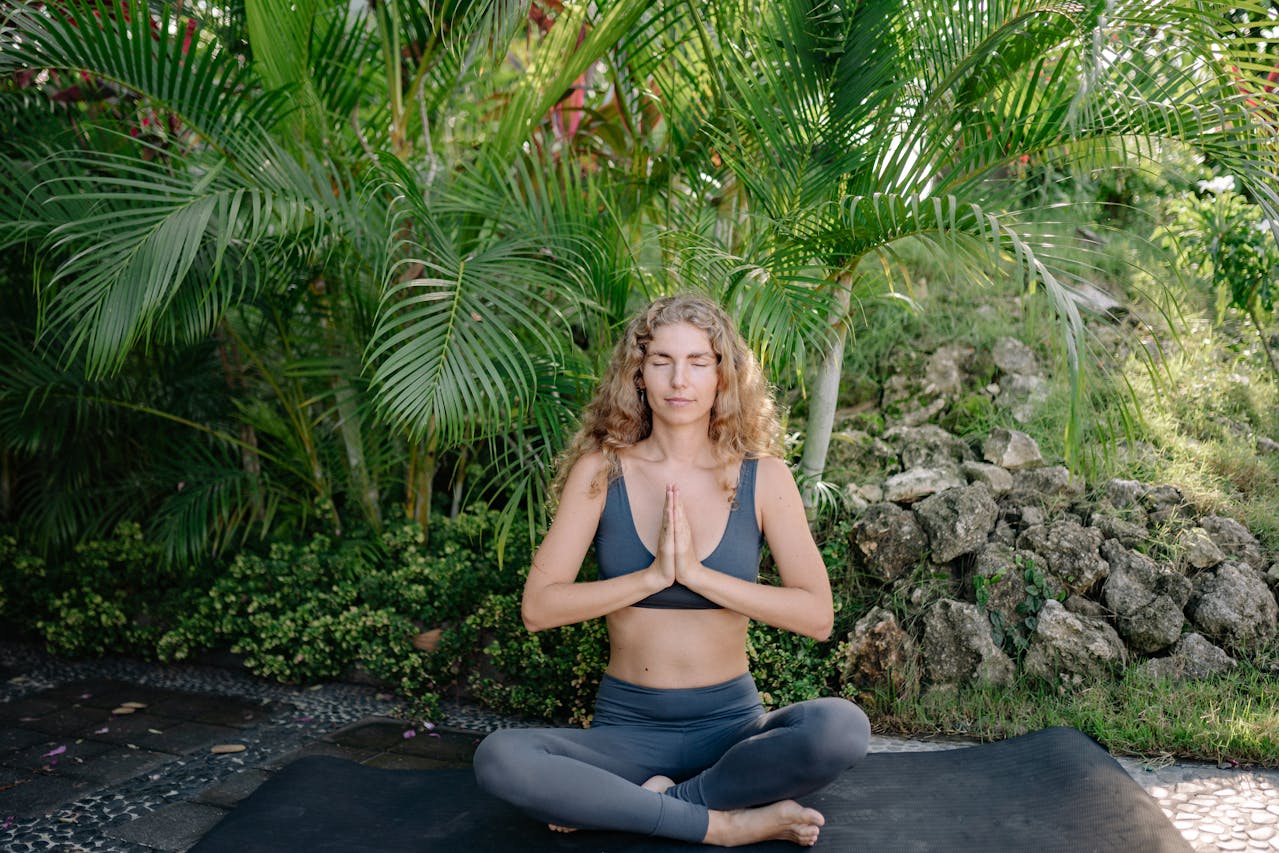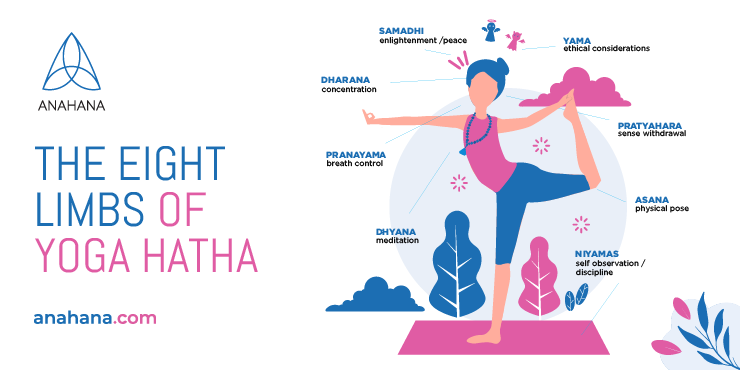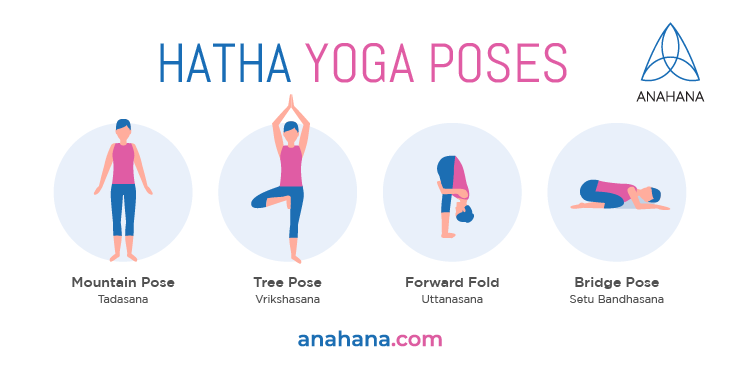
Table of Contents
Hatha yoga consists of a combination of breath work and movement. It also refers to physical postures taught in any type of yoga style.
The History of Hatha Yoga
Hatha yoga is an umbrella term that describes physical exercise and breathing techniques used to achieve mindfulness.
Originating in India, this concept traces back to the eleventh century A.D.; however, posture-based forms of yoga did not develop until the early 20th century. Hatha yoga today is based on the practices outlined in the Hatha Yoga Pradipika.
Hatha yoga began developing in India during the 1920s and 1930s, with the first official school opening in Mysore in 1924. During this time, the Indian traditions of Hatha yoga merged with the physical culture of western society.
Once physical culture grew in popularity in the 20th century, Hatha yoga teachings became popularized in the west.
Hatha Yoga Today
Today, Hatha is practiced regularly by people all around the world. However, it is not practiced in the same manner as classical Hatha yoga once was.
Modern Hatha yoga has shifted to focus on large class sizes that are often drop-in rather than routine sessions with the same group of students. This has made taking yoga classes easier to fit into your schedule at your convenience.
The Sanskrit word Hatha literally translates to force. Hatha classes will teach you how to apply prana, or vital energy, to different yoga postures. Hindu texts describe prana as the physical, mental and spiritual energy in Hinduism. Classes typically last anywhere from 45 to 90 minutes, and you can expect that it will finish with some pranayama yoga or meditation.
Today's Hatha yoga classes are slow and gentle, making them excellent for yoga beginners. Many yogis would recommend you begin with Hatha yoga before trying other forms of physical practice.
Hatha was once seen as the mother of all styles of yoga, as all other styles practiced in western societies derived from this style of yoga. However, it is now seen more like a sister.
The Hatha Yoga Pradipika (HYP)
The Hatha Yoga Pradipika (HYP) is an ancient text written by Indian yogi Nath Yogi Swatmarama in the fifteenth century C.E. The text outlines the principles of Hatha yoga. Swatmarama draws on his experience and past yoga works that have been lost over time.
HYP is the most well-known book of this style, known as one of the most important classical texts of yoga philosophy.
According to Swatmarama, Hatha yoga is “the yoga that is attained through forceful means with difficult physical kriyas and cleansing, purifying actions as beginning practice.” It was written for future students of yoga.
In the modern era, students still rely on the same instruction given by Swatmarama as laid out in his guide.
Eight Limbs of Yoga

The origin of Hatha yoga still embodies the eight limbs. The eight limbs form a sequence from the outer to the inner. They create a guide to making your life meaningful through moral and ethical lessons on the self.
The eight limbs of yoga consist of the following eight steps:
Yama: This focuses on ethical standards and integrity, teaching best practices for behavior and how we present ourselves. The five Yamas are Ahimsa (nonviolence), Satya (truthfulness), Ateya (non-stealing), Brahmacharya (continence), and Aparigraha (non-covetousness).
Niyama: The second limb has to do with spiritual observance and self-discipline. Examples of Niyama are saying grace before a meal or taking nature walks alone. The five Niyamas are Saucha (cleanliness), Samosa (contentment), Tapas (heat; spiritual austerities), Svadhyaya (study of the sacred scriptures and one's self), and Ishvarapranidhana (surrender to god).
Asana: Asana is the physical poses performed during yoga practice. By practicing asanas, we develop a more profound level of concentration and discipline, helping us achieve meditation.
Pranayama: Pranayama generally translates to breath control. It is designed to recognize the connection between breath, the mind, and emotion to control the respiratory system. This may be done through breath retention. The exact translation of Pranayama is "life force extension," as yogis believe it can extend one's life.
Pratyahara: The fifth limb is to withdraw from external distractions and draw your attention within. By detaching from the senses, you can observe your internal thoughts and begin to view them in a new light. This is a mentally challenging step.
Dharana: At this point, you will be relieved of outside distractions so you can shift your concentration within. Here, you will learn to slow down your thinking process by drawing your attention to only a single object. Learning to focus on a single point for extended periods will naturally lead to meditation.
Dhyana: Dhyana is the uninterrupted flow of concentration (Dharana) - also known as meditation. In this state, you will be fully aware and awake without focus. Reaching this state of stillness will take strength and stamina. However, it is part of the process, and you will benefit from the practice as you work towards your goal.
Samadhi: The Sanskrit work Patanjali describes this as a state of ecstasy. During Samadhi, the person meditating will emerge with their focus and transcend the self altogether. It is achieved through the central channel. They will reach an interconnectedness with all living things and experience the bliss of being at one with the universe.
Benefits of Hatha Yoga
There are extensive health benefits to practicing Hatha yoga for the mind, body, and soul. Here are some of the benefits you may reap through regular practice:
-
Improves sleep quality: According to John Hopkins University, the meditative qualities and breathing exercises practiced in Hatha yoga make it effective in improving sleep. Specific postures that support healthy sleep patterns include corpse pose, lying butterfly, and legs-up-the-wall.
-
Builds flexibility and strength: Hatha yoga gradually increases flexibility and strength through physically demanding postures and sequences. This will help you achieve your dream yoga body and further tone your muscles.
-
Decreases stress, anxiety, and depression: One study done with 52 women suffering from anxiety, depression, and stress found that after 12 Hatha yoga sessions, their mental health improved significantly. The yoga classes decreased their anxiety, depression, and stress and improved their mindfulness.
-
Treats chronic pain: Numerous studies suggest that Hatha yoga is an effective treatment for chronic pain, including lower back pain, endometriosis, and knee pain. This demonstrates how yoga can be used as complementary medicine.
Other benefits include, but are not limited to:
-
Helps maintain healthy joints
-
Stimulates the immune system
-
Can reduce inflammation and inflammatory disease
-
Helps develop discipline and self-control
-
Develops balance and proprioception
Hatha Yoga Poses
 Some basic asanas that you may encounter during a typical Hatha class include:
Some basic asanas that you may encounter during a typical Hatha class include:
Mountain pose (Tadasana): Begin standing with your feet hip-width apart. Inhale, raise both arms, and interlock your fingers straight above your head. Shift your weight into the balls of your feet and lift your heels. Feel your body stretch from the toes to the fingertips. Exhale while lowering your arms and heels. Repeat as necessary.
-
Benefits: Tadasana strengthens your legs, back muscles, glutes, and arms and creates stability in the shoulder joints. In addition, it improves postures and balance and relieves sciatic discomfort.
-
Risks and contraindications: Avoid this posture if you have vertigo, a headache, or low blood pressure. In addition, try to engage your hamstrings if you have hyperextended legs to protect your knees.
Tree pose (Vrikshasana): Stand tall, bend your right knee, and place the foot on your inner left thigh. Keep the supporting leg straight and find your balance. Inhale and raise your arms over your head, then bring your palms together in Namaste.
Focusing on an object straight in front of you can support a steady balance. Continue taking long deep breaths and relax into the posture. When finished, slowly exhale, release the right leg, and bring your hands to your sides. Repeat the posture on the left.
-
Benefits: Vrikshasana rejuvenates the body and stretches the back, legs and arms. It balances the mind and improves concentration. In addition, it relieves some cases of sciatica and strengthens the legs, improves balance, and opens the hips.
-
Risks and contraindications: You should avoid this posture if you are suffering from a headache, insomnia, or low or high blood pressure.
Forward Fold (Uttanasana): Begin in raised hands pose (Urdhva Hastasana), sweep your arms down the sides of your body, and come to forward fold initiated by the hips. Keep your fingertips in line with your toes, and if possible, press your palms into the mat. Add a slight bend to your knees, so they are not locked and engage your leg muscles.
Bring your weight into the balls of your feet, keeping your hips above your ankles. Allow your head to hang. Recover from the position by inhaling and placing your hands onto your hip bones. Press your tailbone down, engage your abdominal muscles, and slowly lift up.
-
Benefits: This posture relieves stress and depression, stretches the hamstrings, calves, and hips, and strengthens the thighs and knees. In addition, it stimulates the liver and kidneys to improve digestion. It relieves symptoms of menopause, headaches, and insomnia. Lastly, Uttanasana is therapeutic for conditions including asthma, high blood pressure, infertility, sinusitis, and osteoporosis.
-
Risks and contraindications: If you have a back injury, it is best to avoid this pose or do this pose with bent knees. In addition, if you have a condition that requires you to avoid high pressure in your head, you should avoid this position. Conditions may include dental bone grafts or glaucoma.
Bridge pose (Setu Bandhasana): Begin by laying down in Shavasana with your arms by your sides. Bend your knees so your feet are flat, and clasp your ankle with your palms. Inhale and raise your back in a relaxed motion. Optionally, you can lift the heels to give you a deeper stretch. Maintain this position for at least thirty seconds, and continue taking slow inhales and exhales. Bring your back down with a deep exhale and rest. Repeat this three to five times.
-
Benefits: Setu Banhasana stretches the chest, neck and spine while alleviating stress and depression. It can stimulate the abdominal organs as well as the lungs and thyroid, which helps improve digestion. The posture may reduce anxiety, fatigue, headaches, backaches, and insomnia and relieve menopause and menstrual discomfort. Lastly, bridge pose is therapeutic for conditions including sinusitis, osteoporosis, high blood pressure, and asthma.
-
Risks and contraindications: If you have a neck, shoulder, knee, or back injury, you should avoid performing this posture. In addition, if you are pregnant, consult with your doctor first.
Hatha Yoga Poses That Beginners Should Avoid
If approaching Hatha yoga as a beginner, there are some poses that you should leave out until you are more experienced because they can potentially place a lot of strain on the neck or the knees.
With regards to the neck, if you spend a lot of time at your desk in front of a computer or otherwise looking down at a smart device then three key Hatha poses to avoid as a beginner are plough pose (halasana), shoulder stand (sarvangasana) and headstand (sirsasana.)
Our necks may be compromised from habitual use of smart devices and these poses can place even more strain on the neck if done without the necessary preparation or awareness.
Another type of Hatha yoga pose that you should approach with caution is lotus or variations of poses involving lotus pose. While it does involve natural movements of the knee, this position can be bad for your knees if you aren’t used to doing the particular knee movement involved.
If you are going to work towards headstand, look at learning to align the bones of your neck and engage your neck muscles prior to working towards headstand. For shoulder stand and plough pose, learn how to balance on your shoulders to reduce strain on the back of your neck.
If, when you are ready you choose to approach lotus, or variations of it, the trick here is learning to use muscles that work on your hip and knee to keep your knees safe while moving into lotus.
For these and any other Hatha yoga poses, stop what you are doing or change the way that you do it if you experience sharp joint pain.
Hatha Yoga Frequently Asked Questions
Is Hatha yoga good for weight loss?
Generally, Hatha yoga practice is not suitable for weight loss. Hatha practices are a great form of exercise that can improve many aspects of your health. However, if your ultimate goal is to lose weight, this may not be the type of yoga you are looking for.
According to Harvard Health, one thirty-minute Hatha yoga session will burn 120 calories in a 125-pound person, 144 calories in a 155-pound person, and 168 calories in a 185-pound person.
If your goal is to lose weight, Vinyasa yoga is a more vigorous style that may be a better option for you. The flowing style can help you meet your goals by providing a cardio workout.
Can a pregnant lady do Hatha yoga?
Yes, those who are pregnant can do Hatha yoga. The physical yoga practices are generally safe, making it one of the best styles for pregnant people, along with prenatal yoga and restorative yoga.
Before registering for a Hatha yoga class, make sure you get your doctor's approval. In addition, discuss your pregnancy with your certified yoga instructor so they can modify certain positions for you.
Is Hatha yoga hot?
No, Hatha yoga is not practiced in a heated environment, unlike Bikram yoga and Hot yoga. Hatha yoga generally consists of a gentle introduction to basic yoga postures.
How many Hatha yoga poses are there?
As mentioned earlier, the Hatha Yoga Pradipika is viewed as an anthology that combines many Hatha texts. It includes fifteen primary postures - seven of which are seated, and eight are non-seated. There are an additional 69 postures to give a total of 84 asanas. However, you likely will not perform all of these in just one yoga class.
What is the difference between Vinyasa and Hatha yoga?
Hatha yoga is practiced at a slow pace, focusing on breathing techniques, holding physical postures, stretching, and proper alignment. Although not the only difference, Vinyasa yoga is a fast-paced style that focuses on connecting the breath to movements. In vinyasa, you can expect to continue to flow throughout the practice rather than hold postures.
If you are new to yoga and looking for a slow-paced style with a relaxed learning environment, Hatha yoga may be suitable for you. If you are looking for something more physically challenging, vinyasa yoga is the better option.
References
Bridge Pose: How to Practice Setu Bandha Sarvangasana.
Calories burned in 30 minutes of leisure and routine activities - Harvard Health.
Get to Know the 8 Limbs of Yoga.
Yoga's Long History in the United States
10 Basic Hatha Yoga Poses for Beginners
Hatha Yoga | A brief history and introduction
Prenatal yoga: What you need to know - Mayo Clinic.
Disclaimer
The contents of this article are provided for informational purposes only and are not intended to substitute for professional medical advice, diagnosis, or treatment. It is always recommended to consult with a qualified healthcare provider before making any health-related changes or if you have any questions or concerns about your health. Anahana is not liable for any errors, omissions, or consequences that may occur from using the information provided.

By: Clint Johnson
Clint is the driving force and founder of Anahana. Clint teaches Yoga, Pilates, mindful breathing, and meditation, catering to a global community of students and teachers.